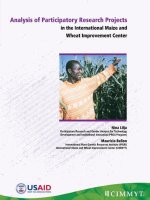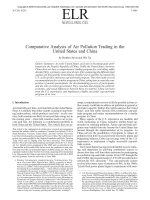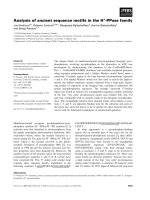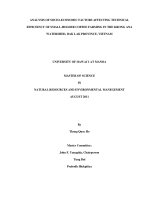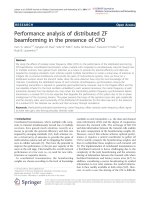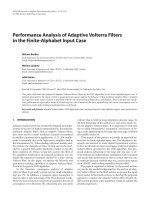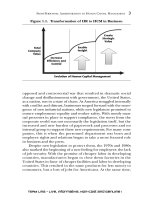Analysis of socio-economic factors affecting technical efficiency of small-holder coffee farming in the Krong Ana Watershed, Dak Lak Province, Vietnam
Bạn đang xem bản rút gọn của tài liệu. Xem và tải ngay bản đầy đủ của tài liệu tại đây (1.41 MB, 88 trang )
ANALYSIS OF SOCIO-ECONOMIC FACTORS AFFECTING TECHNICAL
EFFICIENCY OF SMALL-HOLDER COFFEE FARMING IN THE KRONG ANA
WATERSHED, DAK LAK PROVINCE, VIETNAM
UNIVERSITY OF HAWAI῾I AT MANOA
MASTER OF SCIENCE
IN
NATURAL RESOURCES AND ENVIRONMENTAL MANEGEMENT
AUGUST 2011
By
Thong Quoc Ho
Master Committee:
John F. Yanagida, Chairperson
Tung Bui
Prabodh Illukpitiya
ii
ANALYSIS OF SOCIO-ECONOMIC FACTORS AFFECTING TECHNICAL
EFFICIENCY OF SMALL-HOLDER COFFEE FARMING IN THE KRONG ANA
WATERSHED, DAK LAK PROVINCE, VIETNAM
A THESIS SUBMITTED TO THE GRADUATE DIVISION OF THE
UNIVERSITY OF HAWAI῾I AT IN PARTIAL FULFILLMENT OF THE
REQUIREMENTS FOR THE DEGREE OF
MASTER OF SCIENCE
IN
NATURAL RESOURCES AND ENVIRONMENTAL MANEGEMENT
AUGUST 2011
By
Thong Quoc Ho
Master Committee:
John F. Yanagida, Chairperson
Tung Bui
Prabodh Illukpitiya
i
ANALYSIS OF SOCIO-ECONOMIC FACTORS AFFECTING TECHNICAL
EFFICIENCY OF SMALL-HOLDER COFFEE FARMING IN THE KRONG ANA
WATERSHED, DAK LAK PROVINCE, VIETNAM
A THESIS SUBMITTED TO THE DEPARTMENT OF NATURAL RESOUCES
AND ENVIRONMENTAL MANAGEMENT OF THE UNIVERSITY OF
HAWAI῾I AT IN PARTIAL FULFILLMENT OF THE REQUIREMENTS FOR
THE DEGREE OF
MASTER OF SCIENCE
IN
NATURAL RESOURCES AND ENVIRONMENTAL MANEGEMENT
AUGUST 2011
By
Thong Quoc Ho
Master Committee:
John F. Yanagida, Chairperson
Tung Bui
Prabodh Illukpitiya
i
ACKNOWLEDGEMENTS
Since I enrolled in my graduate program at the University of Hawaii at Manoa, I
have received tremendous assistance and encouragement from individuals and
institutions. First, I would like to express sincere thanks to my academic advisor, Prof.
Dr. John F. Yanagida, who have continuously encouraged and assisted by providing me
invaluable comments and suggestions for my thesis and academic plan as well. I am
deeply indebted to him for all endless support and kindhearted assistance during my
study period.
I would like to express my endless gratitude to Dr. Prabodh Illukpitiya for his
helpful comments and encouragement. He provided extremely gracious suggestions with
productive discussion throughout the thesis research. I am grateful to Dr. Tung Bui for
his invaluable advice on my proposal, keeping track of research implementation
conducted in Vietnam. I hold my committee members, Dr. John F. Yanagida, Dr. Tung
Bui and Dr. Prabodh Illukpitiya, in deep reverence.
I gratefully acknowledge the International Fellowship Program and the East West
Center for providing financial support for my graduate studies.
Much appreciation is extended to students from Tay Nguyen University, namely
Tran Ngoc Nam, Ha Van Dung and Do Thanh Tuyen, who helped with data collection. I
also extend my special thanks to faculty members from Department of economics, Tay
Nguyen University for their advice and encouragement during my graduate studies.
I am grateful to my family and friends, especially my parents, my wife, Hoang
Thi Thu and my son, Ho Hoang Quan, who have exhibited the supreme virtue of patience
and understanding.
ii
I am indebted to more people than I can name. Thank you all for being present in
this unforgettable stage of my life.
iii
ABSTRACT
Title: Analysis of socio-economic factors affecting technical efficiency of
small-holder coffee farming in the Krong Ana Watershed, Dak Lak Province,
Vietnam
Coffee is a major crop in Vietnamese agriculture and plays an important role in
omy, especially in the Central Highlands of Vietnam. Coffee
production is a major source of income for farmers in the Dak Lak province. Although
Vietnam is well-known as one of the largest coffee producers in the world, there is
minimal research and information identifying the technical efficiency and socio-
economic factors contributing to production efficiency of coffee.
The overall objective of this study was to estimate the technical efficiency of
coffee production and evaluate factors affecting the level of technical inefficiency of
small holder coffee farmers in the Krong Ana Watershed of Dak Lak province. The
specific objectives were to (i) identify the factors affecting coffee production, (ii)
estimate the technical efficiency of coffee farming and (iii) identify factors contributing
to technical inefficiency by analyzing the relationship between estimated efficiency levels
and farm specific socio-economic factors.
The study was conducted in four districts of the Dak Lak province. Since pooling
data was not possible in all districts based on the results of the Chow Test, separate
analyses were conducted for Cu Kuin and three combined districts (Krong Ana, Krong
Bong and Lak). Maximum likelihood estimates for all the parameters of the stochastic
frontier and inefficiency model were simultaneously generated. The variance parameters
were estimated in terms of parameterization. By employing the stochastic frontier
iv
approach, the results reveal that selected variables significantly affect coffee output (i.e.,
cost of organic fertilizers, pesticide expenditure, amount of irrigation water and coffee
trees for the Cu Kuin district model; labor, inorganic and organic fertilizer expenditure
and age of coffee trees for the three combined districts model). The estimated mean
technical efficiency scores were 0.7466 and 0.6836 respectively for the Cu Kuin district
and the three combined districts. Formal education of the household head, amount of
credit, ethnicity, and coffee farming experience were key factors which can reduce
technical inefficiency of coffee production for the combined districts sub-region. For the
Cu Kuin district, extension services can be used as a conduit to reduce technical
inefficiency of coffee production, while ethnicity has the opposite effect as compared to a
priori expectations. This latter result requires further research and analysis. Improvement
of technical efficiency by 10% could generate a substantial amount of additional income
for coffee farmers. The overall findings suggest that water conservation practices, and the
proper choice of fertilizers and pesticides could lead to improvements in coffee yields.
Expanding coverage of formal education and making credit more available can help
farmers enhance technical efficiency of coffee production in the combined districts.
Improvements in both quantity and quality of extension services may increase technical
efficiency of coffee production for farmers in the Cu Kuin district. More in-depth
investigation into population policies is necessary to identify the effects of family labor,
number of children and family size on improving technical efficiency of coffee
production for both sub-regions.
v
TABLE OF CONTENTS
ACKNOWLEDGEMENTS i
ABSTRACT iii
TABLE OF CONTENTS v
LIST OF TABLES vii
LIST OF FIGURES: viii
Chapter 1. INTRODUCTION 1
1.1 Background information 1
1.2 Problem statement 3
1.3 Objectives of the study 5
1.4 Testable hypotheses 5
1.5 Outline of thesis 6
Chapter 2. LITERATURE REVIEW 7
2.1 Factors governing coffee production. 7
2.2 Overview of technical efficiency concepts 8
2.3 Factors affecting technical inefficiency 10
2.4 Conceptual framework 13
2.5 Knowledge gaps 16
Chapter 3. RESEARCH METHODOLOGY 18
3.1 Research design outline 18
3.2 Theoretical Model 18
Chapter 4. DATA SPECIFICATIONS AND COLLECTION PROCEDURES 26
4.1 Approach 26
4.2 Data sources 27
4.3 Variable descriptions 27
4.4 Sampling Procedures 29
4.5 Descriptive Statistics 31
4.5 Common Tests for the robustness of the models 32
4.5.1 Chow test 32
4.5.2 Collinearity Testing 33
4.5.3 Testing for Heteroskedasticity 34
Chapter 5. EMPIRICAL MODELS AND ESTIMATION RESULTS 36
5.1 Empirical Models 36
vi
5.2 Results and Discussion: 38
5.2.1 Factors contributing to coffee production 38
5.2.2 Maximum Likelihood Estimates (MLE) and Technical Efficiency 39
5.2.2.1 Analyses of Maximum Likelihood Estimates 41
5.2.2.2 Technical Efficiency 46
5.2.2.3 Analyses for technical inefficiency models 47
5.2.2.4 Efficiency improvements in coffee production 51
Chapter 6. SUMMARY, CONCLUSIONS AND RECOMMENDATIONS 54
6.1 Summary 54
6.2 Conclusions 55
6.3 Limitations of the study 57
6.4 Policy recommendations 58
Appendix A: Descriptive Statistics 71
Appendix B1: Correlation matrix of production factors for Cu Kuin district. 72
Appendix B2: Correlation matrix of production factors for the combined districts. 73
Appendix C: Pairwise t-test for the mean 74
vii
LIST OF TABLES
Table 4.1: Description of production variables 28
Table 4.2: Description of variables of the efficiency model 28
Table 4.3: Descriptive statistics for sample size determination 29
Table 4.4 Sample distribution* 30
Table 4.5 Coffee output per hectare statistics of 4 districts 31
Table 4.6 Chow test for different impacts of independent 32
Table 4.7 Multicollinearity Testing 34
Table 5.1 OLS estimates fo coffee production function models 38
Table 5.2 MLE of stochastic production frontier and technical inefficiency models 40
Table 5.3 Frequency distribution of technical efficiency estimates 46
Table 5.4 Scenario for increasing the efficiency 52
Table 6.1 Change in revenue as the inputs increase by 1% 59
viii
LIST OF FIGURES:
Figure 1.1: Krong Ana Watershed, Vietnam 2
Figure 2.1 Output- oriented technical efficiency 9
Figure 3.1: Stochastic frontier production function (Battese 1992) 24
1
Chapter 1. INTRODUCTION
1.1 Background information
however, following that introduction, coffee production remained relatively low. It
-unification in 1975 and implementation of the
national poli
those migrants from across the country settled in the Central Highlands to instigate
coffee production in this area. After this occurrence, Vietnamese coffee production
increased significantly and Vietnam soon became the fourth largest coffee exporter in
the world. To be specific, in 1998, Vietnam accounted for approximately 6.5% of the
contributing to 13.2%,
ICO, 2010). According to the International Coffee Organization (ICO), Vietnam had
become the second largest coffee producer worldwide trailing only behind Brazil
between the periods of 2000/01 to 2008/09.
2
Figure 1.1: Krong Ana Watershed, Vietnam
3
Coffee is the primary export crop for Vietnamese agriculture and plays an
Highlands of Vietnam and its role in the world coffee market. In these Central
and the Krong Ana watershed in particular. The Dak Lak province has been the
largest coffee producer in terms of both coffee yield and land area in Vietnam.
Therefore, it is apparent that agricultural production in this area has been dominated
by coffee production (Business Portal)
1
. To illustrate, land area, as it relates to coffee
farming in the Dak Lak province, represents approximately 236,200 hectares. The
-farming land area is approximately 270,000
hectares and represents more than ten provinces. Next, the Krong Ana watershed,
known for its large coffee plantations in the province, lies along the Krong Ana River
and includes a part of Krong Bong, Lak, Cu Kuin, and Krong Ana districts within the
Dak Lak province.
These areas represent major contributors to the coffee industry not only in
coffee production within Vietnam, but also in development, production and research
as it relates to the world coffee industry. Thus, it can be proposed that changes in
coffee production within t
livelihood and the provincial economy, but also have an influence in the global coffee
market.
1.2 Problem statement
For developing countries, including Vietnam, the strategy for pursuing
economic growth involves the prospect of sacrificing valuable natural resources
1
Business and Investment Information Portal Dak Lak. Coffee production in Dak Lak province,
available at (accessed on March 10, 2010).
4
through their exploitation. Therefore, by improving technical efficiency this will
result in not only efficient use of these natural resources, but also an increase in coffee
production and subsequently an increase in profits for coffee farming. Pursuit of
technical efficiency also ensures that negative impacts on socio-economic factors are
minimized and thereby, serves as an added incentive for sustainable development.
The Central Highlands of Vietnam is well-known as an area rich in natural
resources with favorable climatic conditions for agricultural development; however,
human resource quality is still poor compared with other regions across the country. A
study by ICARD and Oxfam (2002) shows that ethnic minority farmers have been
limited in the adoption of coffee producing technology and have experienced limited
access to support for their coffee production. This is due to the limited formal
education and the lack of skills necessary to keep up with the continuously changing
coffee industry; as such, these ethnic farmers in the Central Highlands of Vietnam are
experiencing more difficulty in reaping benefits from this fast growing coffee industry
(Marsh, 2007). It is this relationship among socio-economic factors such as education
level which plays an important role in problem solving, e.g., the efficient use of
natural resources and developing strategies to achieve sustainable development in the
study area.
Although Vietnam is known as one of the largest coffee producers in the
world, there is minimal research and information regarding coffee production in this
area, in particular, efficient coffee production and socio-economic factors influence
coffee production efficiency. This study is important because it investigates resource
use in coffee production and subsequently efficient use of these resources. Although
this study examines the potential development in the Dak Lak province, these results
can be applied to other areas having similar characteristics and problems. The
5
findings of this research will be a useful source of information for coffee producers
and policy makers seeking production strategies for coffee development.
1.3 Objectives of the study
The overall objective of the study is to estimate the technical efficiency of
coffee farming and to evaluate factors affecting the technical inefficiency in small
holder coffee farms in the Krong Ana Watershed, Dak Lak province, Vietnam.
Results from this study could suggest policy measures to improve coffee farming in
this area. The specific objectives are three-fold:
(1) Identify factors governing coffee production in the Krong Ana watershed,
Dak Lak province, Vietnam;
(2) Estimate technical efficiency in coffee farming through the stochastic
production frontier;
(3) Identify factors contributing to technical inefficiency by analyzing the
relationship between estimated efficiency levels and farm specific socio-economic
and geographic factors.
1.4 Testable hypotheses
Whether the Ordinary Least Square (OLS) or Maximum Likelihood Estimate
(MLE) is adequate to capture the data? The null hypothesis is that the stochastic
production functions for coffee production in the research sites do not exist. Rejecting
the null hypothesis implies that the conventional estimation (OLS) is not adequate to
represent the data and MLE is more appropriate.
By estimating a Cobb-Douglas function, the role of each input factor in coffee
production can be analyzed. In order to do so, one should determine the appropriate
input variables in production.
6
The testable hypotheses for factors affecting coffee output are whether the
estimated regression coefficients associated with coffee input variables are
statistically equal to zero. Rejection of the null hypotheses is expected for estimated
regression coefficients. Therefore, how and by how much these factors affect coffee
output will be determined and analyzed.
The existence of technical inefficiency of coffee production will also be tested.
The null hypothesis for the existence of technical inefficiency is that there are no
inefficiency effects in coffee production. The rejection of this null hypothesis implies
that technical inefficiency does exist in coffee production.
As a corollary to the existence of technical inefficiency, the hypothesis
involving the effects of socio-economic factors on technical inefficiency is tested. The
null hypotheses are that estimated coefficients of socio-economic variables are zero.
The rejection or acceptance of these null hypotheses identifies factors which
significantly affect technical inefficiency of coffee production.
1.5 Outline of thesis
This study includes 6 chapters in total. The second chapter reviews the
relevant literature. More specifically the content of this chapter explains comparison
of previous studies specifying their shortfalls and ho the proposed study addresses
those shortfalls. Chapter 3 develops the research methodology used in this thesis. The
fourth chapter details the data collection procedures, and describes the data collected.
Chapter five examines the analytical results of the stochastic production frontier
model and the inefficiency model. The last chapter summarizes this research, provides
conclusion related to research findings and suggests policy recommendations.
7
Chapter 2. LITERATURE REVIEW
There have been a number of studies on the economics of resource issues and
farm specific factors affecting production efficiency e.g., Huang and Liu (1994),
Cardenas et al. (2005), and Nchare (2007). Socio-economic factors such as labor,
fertilizers and pesticides and resources such as irrigation water, and land play vital
roles in modern-day economies and society as they relate to coffee production. Each
of these contributors has particular characteristics that can be quantified and
appropriately applied in multiple ways. For example, Nachare (2007) found that land,
labor, fertilizers, pesticides and capital positively affected Arabica coffee output.
Approaching social effects and economic resources in terms of efficiency is
especially necessary for every economy as it can help to see how technical efficiency
affects resource use by comparing actual production levels with the maximum
possible output levels. If a producer is able to obtain a high technical efficiency score,
which is considered as a point close to the production frontier, this infers that the use
of resources is efficient and that the socio-economic factors positively affect
efficiency. Moreover, the increase in production potential, that is achievable, may be
determined.
2.1 Factors governing coffee production.
A number of studies have examined input factors affecting agricultural
production in general and coffee production in particular. For instance, Nchare
(2007) considered labor in person-day, fertilizers in physical units, pesticide costs and
age of coffee producers as input factors for coffee production function. Similar
application of factors for the production frontier function of small food crop
8
production in Cameroon was also found by Kolawole and Ojo (2007), implying the
important roles of labor and fertilizers and other inputs as well. In addition, Illukpitiya
and Yanagida (2004) showed that labor, inorganic and organic fertilizers are primary
input factors for paddy production in Sri Lanka. These factors were also employed by
Chen et al., (2009) for Chinese farms, (also see Alvarez and Arias (2004); Binam et
al. (2004); and Illukpitiya and Yanagida (2010)).
Irrigation is another key factor, influencing coffee production in Vietnam (Chi
owever, previous studies suggest conflicting
optimal strategies with varied water application amounts. For example, Cheesman et
al. (2007) found coffee smallholders in the Dak Lak province tend to over-irrigate by
a factor between 2.2 and 5 times the dosage required to achieve the most favorable
. While
an optimal
efficient use of water to be around 1,000 cubic meters per hectare during flower
setting of coffee production. Local authorities suggest that during the dry season, from
November to April of the following year, irrigation application of 3,300 cubic meters
per hectare is the most favorable condition for coffee plantations
Luu, 2002).
2.2 Overview of technical efficiency concepts
ability to develop the greatest amount of output possible from a fixed amount of
inputs. In other words, an efficient producer is one that given a state of technical
know-hows can produce a given quantity of goods by using the least quantity of
possible inputs (Nchare, 2007). Another description of technical efficiency includes
9
the ability to minimize input use in the production of a given output vector, or the
ability to obtain maximum output from a given input vector (Kumbhakar and Lowell,
2000).
According to Nchare (2007), the first analyses of efficiency measures were
initiated by Farrell (1957). Drawing from Debreu (1951) and Koopmans (1951),
Farrell proposed a division of efficiency into two components: technical efficiency,
ze output from a given level of
inputs, and allocative efficiency, which is the ability of a producer to use inputs in
optimal proportions, given their respective prices and available technology.
Subsequently, a combination of the two measures yields a measure of economic
efficiency.
Figure 2.1 Output- oriented technical efficiency
Figure 2.1 shows the output-oriented measures of technical efficiency; for
example, an observed production plan (X
B
, Y
B
) is illustrated by point B, in Figure 2.1.
The vertical length that connects points A and B (AB) is the amount of output that
could increase while input N remained fixed on the x-axis; thus, according to
10
Kumbhakar and Tsionas (2006), the ratio of AB/AN represents output-oriented
technical inefficiency.
2.3 Factors affecting technical inefficiency
Since the study completed by Farrell (1957), a number of additional empirical
studies have evaluated production efficiency. Many studies such as Aigner et al.,
(1977), Battese (1992), Bravo-Ureta and Pinherio (1993), Battese and Coelli (1995),
Binam et al. (2004), Illukpitiya and Yanagida (2004) and Rios and Shively (2007)
have highlighted effects of common socio-economic variables such as age, education,
experience, gender etc. on technical efficiency. Among the literature on technical
efficiency, several selected studies are relevant to the topic of agricultural production
and specifically to coffee production.
A study on the paddy farming sector in Sri Lanka (Illukpitiya and Yanagida,
2004) showed that educational level, experience of the head of household, age of the
head of household and extension contacts, had positive and significant impacts on
technical efficiency. This study found that farmers with more experience were
superior technically in the efficient use of resources. Technical efficiency in this study
is represented by an estimated mean value of 74% and ranging from 34% to 95%. The
finding of this study also showed that there is potential for increasing the efficient use
of resources of paddy farming and thereby improving farm revenues.
In their study on technical efficiency among smallholder farmers in
Cameroon, Binam et al. (2004) selected several interesting variables affecting
technical efficiency in the agricultural sector. For example, variables such as the
distance of the farm plot from the main access road, the soil fertility index and credit
access, all had a significant relationship with the efficiency of farmers among farming
11
systems in the slash and burn agriculture zone. On the other hand, educational levels
had a significant impact on the technical efficiency of maize mono-cropping systems
and an insignificant influence on the technical efficiency of other crops. The study
indicates that the mean technical efficiency levels for groundnut, maize-groundnut
and maize are 71%, 73% and 75% respectively.
Binam et al. (2004), in Cameroon, also reports that the variable, club
membership of a household member, plays a role of social capital in providing
incentives for efficient production. This variable has a negative and statistically
significant effect on technical inefficiency. Also, this study finds that access to cash
credit is likely to increase technical efficiency of farmers in the slash and burn
agriculture zone of Cameroon, by providing funds to reduce capital constraints
hindering agricultural households.
In addition, an analysis of production efficiency involving Mexican coffee-
producing districts by Cardenas, et al. (2005), showed that from 1997 to 2002, coffee
producers experienced a high level of technical efficiency on average, which
increased by 1.04% (0.9586 to 0.9720) during this period. The estimation of technical
efficiency ranged from 0.89 (least efficient) to 0.996 (most efficient). This increase in
technical efficiency relates to infrastructure use, therefore, having a positive influence
on the efficiency of coffee production, an unexpected observation. More specifically,
this study hypothesized that the availability of roads is a factor impacting coffee
productivity. Results revealed that road availability was negatively related to
agricultural production, an unexpected outcome. On the other hand, factors such as
population density, altitude, and the proportion of cash crops to coffee based on
monetary value positively contributes to the level of technical efficiency in coffee
production.
12
In a di Binam et al. (2003) report that
technical efficiency results are much lower than previous studies of technical
efficiency in the agricultural sectors. This study shows that technical efficiency scores
vary widely, ranging from 0.02 to 1, with a mean value of 0.36 when using the
Charnes et al. model (1978), and from 0.05 to 1, with a mean value of 0.47 when
using the Banker et al. model (1984). This could imply that improvements in coffee
yield are significant because there were a number of households with actual output far
below the production frontier.
Binam et al. (2003) also suggest in their study
club or association, family size, and residence status of the farmer, have significant
influences on technical efficiency of coffee production in the area. To
be specific, t
coffee yield while the residence status of the farmer significantly influences technical
efficiency. This study also reveals statistically significant results that younger heads
of households are more efficient than older heads of households. In contrast,
accessibility to credit, farming system, land tenure, farm management contract and
distance from the house to the farm for this study are not statistically significant. A
Yanagida (2004) in Sri Lanka. The latter result is that the level of formal education,
commonly measured by the number of years of schooling, does not clearly influence
technical efficiency in coffee farming. However, Nchare (2007) found that there were
positive relationships between technical efficiency scores and educational level of
coffee producers in Cameroon and access to credit also significantly and positively
affected technical efficiency of coffee production. Additionally, Illukpitiya and
13
Yanagida (2010), and Kolawole and Ojo (2007) also indicated a similar results of the
effects of education and credit on technical inefficiency of agricultural production.
Muhammad-Lawal et al., (2009) revealed that young people may not be able
to contribute to agricultural production activities because young people are likely to
be in school. Thus, the ratio of number of children and family size can be explained as
a child dependency index that may affect the technical inefficiency of agricultural
production.
A recent study examining technical efficiency of organic and conventional
coffee farming in Kona, Hawaii (Masuda, et al. 2010), shows that reducing chemical
inputs in conventional Kona coffee farming can improve coffee yields. The estimated
efficiency levels were 0.5775 and 0.4696 respectively for organic and conventional
coffee farming.
From this overall analysis, the educational level of the household head is
positively related to the technical efficiency (see for example, Illukpitiya and
Yanagida, 2004; Binam et al. 2004; Kehinde, et al. 2010; Nchare, 2007), whereas,
Rios and Shively (2007) report that increased educational attainment by household
heads of small farms is a factor reducing efficiency. This is perhaps because more
education increases opportunities for off-farm work and thereby decreases on-farm
management intensity. Access to credit has a negative influence on technical
inefficiency which is statistically significant (Nchare, 2007) while other studies did
not incorporate this factor.
2.4 Conceptual framework
Masuda, et al. (2010) and Binam et al. (2003) indicate that technical efficiency
scores in coffee production are lower than other agricultural production; however,
14
Cardenas, et al. (2005) found that the level of technical efficiency for coffee
production in Mexico, specifically, to be very high. Moreover, since Illukpitiya and
Yanagida (2004) show potential efficiency improvement for paddy farming in their
study, then coffee, which commands a much higher market price, could in turn have
greater potential than rice production if improved with the same efficiency. For
example, if inefficiency is evidenced in coffee farming systems, there is a potential to
improve income of farmers by reducing technical inefficiency. Therefore, this
potential increase in technical efficiency could lead to higher income from coffee.
Thus, a study examining the technical efficiency of coffee production for the Dak Lak
province, known as the largest coffee plantation in Vietnam, has significant
importance and value to coffee producers and the economy of Vietnam.
The OLS method is frequently employed to estimate the production function.
This procedure estimates the production function with the assumption that there is no
efficiency term. However, to investigate technical efficiency and socio-economic
factors affecting technical efficiency, the MLE is a commonly used method for
analyzing inefficiency effects (see Kumbhakar et al. (1991) and Reifschneider and
Stevenson (1991)). This approach is known as the one-step procedure to
simultaneously estimate parameters for both the stochastic production function and
inefficiency model. Huang and Liu (1994) proposed that the technical inefficiency
among these factors.
In this study, the dependent variable is coffee yield for a particular crop year.
expenditures on inorganic fertilizers, organic fertilizers and pesticides, amount of
irrigation water applied, and age of coffee trees. Previous studies also utilized similar

